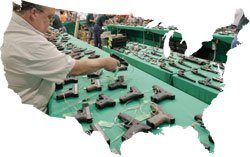January 30, 2011
David Hemenway is Professor of Health Policy and Director of the Harvard Injury Control Research Center. He is also the author of Private Guns, Public Health, which describes the public health approach to reducing firearm violence, and While You Were Sleeping: Success Stories in Injury and Violence Prevention, which portrays more than 30 heroes who have made the world safer.
Q: We’ve had a series of high-profile mass shootings recently in the U.S. What policies might prevent these assaults?
A: Many simple and sensible policies could help prevent and reduce the harm from these attacks. Every one of the more than two-dozen nations considered “high-income” by the Organization for Economic Cooperation and Development has figured out a way to have fewer of these shootings than the United States. For starters, you don’t let people buy guns with high-capacity magazines that allow them to fire scores of bullets without reloading. You make it very hard rather than very easy for questionable people such as the Tucson and Virginia Tech shooters to gain access to firearms. For example, you can have serious background checks. The Tucson shooter would never have passed a comprehensive background check because of past drug use, or been readily granted firearms by most other developed nations.
Q: A gun is certainly more of a weapon than a car. So why don’t we regulate guns at least as strictly as we do cars?
A: Most Americans, and indeed most gun owners, indicate that they would support the dozens of sensible gun policies that are discussed in my book Private Guns, Public Health. These measures include mandatory training, background checks for all gun transfers, a requirement that firearm serial numbers be difficult to erase, and that semiautomatics be unable to fire when the magazine is removed—unlike the situation now, in which many semiautomatics leave a single bullet in the chamber when the magazine is removed. Even the majority of self-professed National Rifle Association members back most of the measures. While some states have enacted some of the policies, none of these measures is a national requirement. In the United States, single-issue lobbies like the gun lobby often have incredible power and can override the desires of the general population.
Q: So how can we make this debate less polarized?
A: Unfortunately, I believe the gun lobby thinks it benefits from the polarization. They certainly promote it. They portray anyone who wants to talk about the public health problems related to guns as “anti-gun,” and “gun control” as wanting to take away people’s guns. The United States has a lot of guns—and a lot of cars. Public health is about trying to figure out how to live with cars, and about trying to figure out how to live, rather than die, with guns.
Q: Just as public health measures have helped people live more safely with cars, what can public health do to help society live more safely with guns—even if the discussion is polarized?
A: Public health is about prevention, and one focus is to go upstream to try to stop the problems early. Say a 17-year-old Boston gangbanger shoots an 18-year-old. Some of the questions that public health asks are: Where did the gun come from? How did it get to an adolescent in Boston? Who is trafficking it? Virtually everyone is in favor of throwing gun traffickers in prison.
Another way we can help is through communication. When Boston public high school students carry guns, we want to know both why they do and how they are able to. We have a study showing that these students wildly overestimate how many of their peers carry guns, in the same way they wildly overestimate who’s having sex or who’s getting drunk. That misperception leads to more of them carrying guns, since most are carrying for protection against peers who they believe are armed.
One of the questions we always ask students is, “What kind of world do you want to live in—a world where it’s easy for teens to get guns or where it’s difficult or impossible for teens to get guns?” The large majority always wants it to be impossible—even most kids who have already carried guns illegally. I believe it is our fault as adults that we have created this dangerous environment for them. Adults in every other developed country have done better by their children.
Among the more than two dozen high-income countries in the world
- 80% of all firearm deaths occur in the U.S.
- 85% of all the women killed by firearms are U.S. women.
- 90% of all the youth ages 15–24 killed by firearms are U.S. youth.
Thea Singer is a Boston-based science journalist and author of the new book Stress Less.
Photo: Reuters
